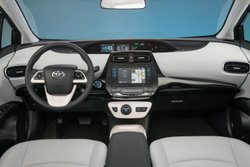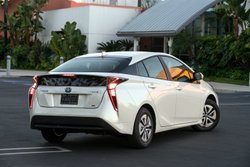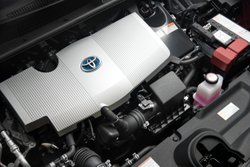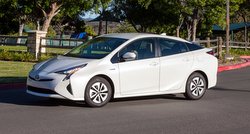More of Everything—And a Radical Look
Toyota’s Prius Liftback had a good thing going for several years as the “official” vehicle of the environmentally conscious, a reputation that became cast in concrete during the 2003 Academy Awards, when dozens of Hollywood celebrities arrived in chauffeur-driven Priuses.
But the cachet of the Prius has dissipated over the years as its fuel economy advantage over the competition shrunk substantially. Add to that, gas prices have been at historic lows for some time, which is driving consumers to pass up family sedans in favor of crossover SUVs.
Through the end of August, 2016 Toyota Prius Liftback sales have declined 10 percent compared to the same period in 2015, which saw a sales loss of more than 16 percent from the previous year.
That said, the Prius Liftback remains the world’s top-selling hybrid vehicle, and the new 2016 fourth-generation edition will carry on with that title intact. The new version is all-new from the ground up with an even more radical look, vastly improved ride and handling, a much nicer and quieter interior and, yes, even better fuel economy.
Every new Prius achieves 52-mpg combined fuel economy, while the Prius Two Eco boosts that number to 56-mpg.
Driving the 2016 Toyota Prius

Slipping into driver’s seat of the 2016 Prius Three test driver, there was an immediate familiarity—the speedometer, gauges and multi-information display screen were still centered in the dashboard below the windshield and the stubby gearshift lever sprouted from the center console.
Like the previous model, you can’t take off from a stop on battery power alone. You have to accelerate to around 35 mph, lift your foot momentarily, and then gently apply pressure. If the battery has a full charge, the Prius will cruise for up to two or three miles before the engine has to take over.
From there on, the new Prius was nothing like driving the outgoing model.
The first two days was relegated to in town driving, and to maximize fuel efficiency, we engaged the Eco mode, which subdues the accelerator pedal’s response, as well as optimizing how the air conditioning and heater operate.
The slower pace might take time for some to get used to, but in Eco mode driving the Prius on city streets was effortless. It went about its business of burning little gasoline without changing the way we normally drive. After chalking up 112 miles, we averaged 60.4-mpg. That’s 8-mpg better than the EPA rating.
However, regardless of how you drive, tailpipe emissions will be the same, almost none.
The 2016 Toyota Prius Liftback is built on the Toyota New Global Architecture (TNGA), a platform that is much stiffer and delivers a more rewarding driving experience, not a past Prius strong

suit. Linking the rigid chassis to the pavement is an independent McPherson strut suspension up front, while a first-time double wishbone independent rear suspension dresses the rear.
This setup works wonderfully. When boulevard speeds are reached, the connection to the road feel is now acceptable, and the ride is supple over almost any surface. It handles uneven pavement easily, and unseen potholes won’t jar your back teeth as the previous car did.
The big surprise for me was the Prius is now likeable on long drives. On a 337-mile round trip, including a planned 41-mile excursion on a twisty two-lane highway, I arrived relaxed without any aches or discomfort, thinking there’s no reason I had to give up a pleasant driving experience to get great gas mileage.
Everything was pleasant and competent, abetted by a nicely weighted, responsive steering. In a straight line, the car felt solid and well planted, and the engine was quiet and relaxed most of the time. I drove in Eco mode much of the way, switching to Normal when climbing hills, and occasionally engaging the Power mode for some additional zip for passing.

As for that 41-mile detour, it’s one of our favorite routes that starts with flat farmland that turns into a hilly forest before hugging the shore of Puget Sound. The new Prius doesn’t compare to the fun of driving the Volkswagen Jetta Hybrid, but it has decent grip and tucks into corners that the old one merely slogged around. The brake pedal has a firm feel and slows or stops the car in a manner akin to cars without regenerative brakes.
As good as the 2016 Toyota Prius Liftback is, it has some of the same demerits as the previous car, starting with the crossbar that splits the rear glass into two parts, disrupting the view through the rearview mirror. Then there’s the gauges positioned in the middle of the dashboard that Toyota introduced on the 1999 Echo. Even after driving several thousand miles in Priuses, it just doesn’t feel normal.
What is normal is the extraordinary fuel efficiency—during our week with the 2016 Prius we drove 449-miles and averaged 58.7-mpg.
How Does The Prius Get That Fuel Economy?

Toyota’s Hybrid Synergy Drive powertrain basic design hasn’t changed: a small four-cylinder engine, two motor/generators, a battery pack, regenerative brakes and a continuously variable transmission (CVT). What’s changed over the years are the component parts, so, it’s not magic. It is hard core engineering that results in each new generation Prius eeking out improved fuel economy.
The gasoline internal combustion engine part remains a 1.8-liter Atkinson-cycle four-cylinder, but it’s been redesigned top to bottom. It’s the first engine in the world to achieve maximum thermal efficiency of 40 percent. Engine output is 95 horsepower and 105 pounds-feet of torque.
A redesigned CVT transaxle is smaller with a new motor the produces 71 horsepower along with 121 pounds-feet of torque. Under acceleration, the combustion and electric motor pool their resources to provide a combined system output of 121 horsepower.
New for 2016 is a small lithium-ion battery except for base Prius Two, which carries on with the reliable nickel-metal hydride battery.
About The Styling
With the exception of the first-generation car introduced in 1999, the Prius never looked like a normal car. Making its debut in 2009, the third-generation model followed the second-gen car’s

distinct shape. While highly recognizable, it’s doubtful that many owners bought a Prius for its looks.
Not everyone likes the polarizing looks of the 2016 Prius and will choose not to buy it because of the aggressive styling change. In profile the new Prius retains the basic shape of the outgoing model, but viewed from the front, the car looks like a candidate for a space shuttle. Dramatic character lines lead back to dramatic vertical taillights that are reminiscent of 1950’s tailfins.
Inside is much calmer with a conventional wrap-around dash and new center console that replace the “flying buttress” console layout. Cheap plastic material has been discarded in favor of high-end looking plastic, and on top-end trim’s white ornamentation in the lower sections of the cabin has the look of fine bone china.
Seats, both front and rear, have been redesigned and are now comfortable for long trips. The new car is 2.4 inches longer and half an inch wider, which provides more passenger room and cargo volume.
The 2016 Toyota Prius Liftback continues to be nicely equipped. The base model Prius Two with a starting price just over $25,000 is configured with popular features like an automatic climate control system, a 6.1-inch touchscreen, Bluetooth connection phones and audio devices, a rearview camera, push-button start, and keyless entry on the driver’s door.
If fuel economy is your thing, for an additional $500, the Prius Two Eco is EPA rated at a record-setting 58-mpg city/53 highway/56 combined. That makes it the most fuel-efficient car without a plug.
There are four other Prius trim levels, each with more features, topping off with the Four Touring with a price starting at $30,865. Checking off all the option boxes adds an additional $3,500.
In The Marketplace

The 2016 Toyota Prius Liftback remains one of the least expensive hybrids you can buy. Only two other hybrids have a lower starting price: the smaller Prius c and the two-seat Honda CR-Z that manages only 37 mpg combined.
The Prius is a dedicated hybrid that doesn’t have a direct competitor. But, if you really can’t go with its new styling or need a larger car, Honda’s Accord Hybrid, the Ford Fusion Hybrid, Hyundai’s Sonata Hybrid and the Toyota Camry Hybrid should be on your shopping list. But remember, they don’t deliver the fuel economy that the Prius does and they cost more.
If, after cross shopping, you come back to the 2016 Toyota Prius Liftback, it is the most proven of them all and not likely a losing proposition. It’s one of the most conservative bets on an “alternative technology,” and maybe that’s why it remains by a large margin the sales king of them all.
Related Stories You Might Enjoy:
Two other perspectives on the 2016 Prius—Steve Schaefer and Michael Coates
Road Test: 2014 Prius c
Road Test: 2013-14 Honda CR-Z
Road Test: 2017 Honda Accord Hybrid
Road Test: 2016 Hyundai Sonata Hybrid
Road Test: 2016 Toyota Camry Hybrid
Road Test: 2014 Ford Fusion Energi
Disclosure:
Clean Fleet Report is loaned free test vehicles from automakers to evaluate, typically for a week at a time. Our road tests are based on this one-week drive of a new vehicle. Because of this we don’t address issues such as long-term reliability or total cost of ownership. In addition we are often invited to manufacturer events highlighting new vehicles or technology. As part of these events we may be offered free transportation, lodging or meals. We do our best to present our unvarnished evaluations of vehicles and news irrespective of these inducements.
Our focus is on vehicles that offer the best fuel economy in their class. We also feature those that are among the top mpg vehicles in their class. In addition, we aim to offer reviews and news on advanced technology and the alternative fuel vehicle market. We welcome any feedback from vehicle owners and are dedicated to providing a forum for alternative viewpoints. Please let us know your views at publisher@cleanfleetreport.com.

13 thoughts on “Road Test: 2016 Toyota Prius Liftback ”